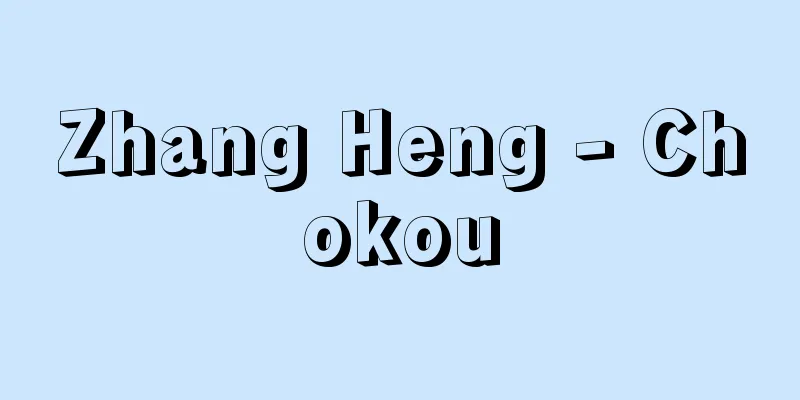Zhang Heng - Chokou

|
A Chinese writer and scientist from the Later Han Dynasty. He was from Xie County, Nanyang (Nanyang County, Henan Province). His pen name was Hei-ko. He excelled in fu (comics), and wrote Fu (Fu to the Xijing) and Fu (Fu to the Tokyo Metropolitan Area) (collectively known as Fu to the Two Jings), which described the customs of Chang'an and Luoyang, and satirized the people's indulgence in luxury. His works are included in the Wen Xuan, along with Fu (Fu to the Southern Capital), which praises Nanyang, the hometown of himself and Emperor Guangwu, as well as Fu (Fu to the Sixuan People's Return to the Countryside). He excelled in astronomy, calendar calculations, and machine building, and became Taishi Ling (director of the National Astronomical Observatory) during the reigns of Emperor An and Emperor Shun. He wrote astronomical documents such as the "Hun Tian Yi Zhu" and "Ling Xian" on the theory of the armillary sphere and the armillary sphere, and created a hydraulic armillary sphere, a celestial globe, a compass, and a wooden carved bird (a flying wooden bird). In 132 he made the Hou Feng Ji Do Yi, an earthquake detection device that could also determine the direction of the epicenter. He abolished superstitions such as the theory of divination and was strict with those in power, so he was transferred to the position of assistant to King Hejian, but he made good achievements there and was summoned to the position of Minister after three years, where he died in 139. He wrote "Si Sorrows Poem," his first seven-character poem, in his later years, and is considered a masterpiece. [Kazuhiko Miyajima] [Reference items] | | | | | |Source: Shogakukan Encyclopedia Nipponica About Encyclopedia Nipponica Information | Legend |
|
中国、後漢(ごかん)の文人、科学者。南陽、西鄂(せいがく)県(河南省南陽県)の人。字(あざな)は平子。詞賦に秀で、長安と洛陽(らくよう)の風俗を描いた『西京賦』『東京賦』(あわせて『二京賦』)をつくり、人々が奢侈(しゃし)に走るのを風刺した。自身や光武帝の出身地南陽を賛美した『南都賦』や、『思玄賦』『帰田賦』などとともに『文選(もんぜん)』に収められている。天文・暦算や機械製作にも優れ、安帝・順帝のとき太史令(国立天文台長)となり、渾天(こんてん)説と渾天儀に関する『渾天儀注』や『霊憲』などの天文書を著し、水力で自動回転する渾天儀、天球儀や指南(しなん)車、木雕(もくちょう)(自分で飛ぶ木製の鳥)などをつくった。132年製作の候風地動儀は震源地の方向もわかる地震感知装置であった。図讖(としん)(讖緯(しんい)説)などの迷信を廃し、権力者にも厳しかったため河間王の補佐役に転出させられたが、そこでも治績をあげ、3年間で召喚されて尚書となり、139年没した。晩年の『四愁詩』は最初の七言詩であり、秀作とされる。 [宮島一彦] [参照項目] | | | | | |出典 小学館 日本大百科全書(ニッポニカ)日本大百科全書(ニッポニカ)について 情報 | 凡例 |
Recommend
Nightgun
At the same time, musical works of Jewish origin ...
Schoenobiinae
…The Japanese species are classified into the fol...
Tsuchida Bakusen
Japanese painter. Born in Sado, Niigata Prefectur...
Emperor Xuan
91 to 49 China, former Han Emperor Liu Xun of the ...
Oberon (English spelling)〈German〉Oberon
Same as "Oberon." Wieland's epic poe...
Bubalus bubalis (English spelling) Bubalusbubalis
...Buffaloes, including males, have no neck fur, ...
Nimitz, Chester William
Born February 24, 1885 in Fredericksburg, Texas. [...
Rubus microphyllus (English spelling) Rubus microphyllus
… [Matsui Jin]. … *Some of the terminology that m...
Danzig
…Population: 463,100 (1995). Also called Gdańsk, ...
Transition elements - Sen'igenso
According to the IUPAC definition, an element wit...
Modern Democratic Politics
...First of all, is democracy participation (poli...
Meynert, TH (English spelling)
...Sometimes, it is accompanied by a dream-like c...
Management stock - Management stock
…However, in reality, only a very limited number ...
Faylaka
Kuwaiti Muslims are slightly more Sunnites than M...
Powerful - Gouriki
It refers to someone who carries luggage. Current...



![Shimagahara [Village] - Shimagahara](/upload/images/67cbc9e36bcfe.webp)





